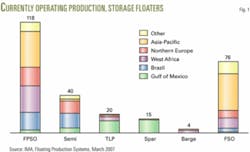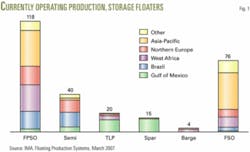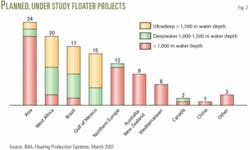Floating production expanding rapidly
During the last year, the world has seen a 10% increase in the number of operating floating production systems.
Currently 197 floating production systems are operating worldwide. Another 62 systems are on order for delivery within the next 3 years.
Also and most importantly, underlying market fundamentals have never been stronger because floating production is a development option being studied in more than 100 projects in the planning stages.
As a result, International Maritime Associates Inc. (IMA) has raised by 15% its 5-year forecast of production floater orders.
Production floaters
The current production floater inventory in operation has 118 floating production, storage, and offloading vessels (FPSOs); 40 production semisubmersibles; 20 tension-leg platforms (TLPs); 15 production spars; and 4 production barges (Fig. 1). These units produce fields primarily off West Africa, Northern Europe, US Gulf Coast, Brazil, Southeast Asia, China, Australia, and New Zealand.
Another 76 floating storage and offloading vessels (FSOs) are in service, primarily in Southeast Asia, West Africa, and the North Sea.
Leasing companies that charter the units to field operators and generally, but not always, provide operational services own about 40% of production and storage units in use. Field operators that either operate units with their own personnel or engage an operating-management company own the remaining 60%.
The mix of leased and owned units among different types of floating production systems varies considerably. About 50% of FPSOs and 60% of FSOs are leased, while only 15% of other production units are leased.
Strong market
Fundamentals driving the floating production sector have never been stronger. Crude futures prices 6 years out are in the mid-$60/bbl range, and crude prices of $50/bbl or more have gained increased acceptance as the measure for project hurdles.
The lure of $60/bbl crude is drawing capital into the floating production sector. Industry has made speculative investment of more than $3 billion in a dozen production floaters now on order without field contracts.
Future offshore exploration and production activity is extremely positive. IMA expects capital budgets for exploration and production spending to increase 10-15% in 2007, with many companies earmarking deepwater as their spending priority.
Deepwater drilling rig demand is bursting at the seams, with rates for high specification floaters passing $500,000/day. These high rates have made building new rigs attractive; and therefore, drilling contractors will have available a surge of new deepwater drilling vessels during the next few years, eliminating some constraints on exploration and development that have slowed deepwater projects in recent years.
These indicators suggest that growth of floating production clearly has room to expand.
Planned projects
IMA’s recently published study has identified 109 offshore projects in the planning pipeline that potentially require floating production systems (Fig. 2).
Asia has the largest concentration of new projects, with 24 known floater projects. Of these 14 are at bidding or final design stage.
West Africa has the second largest concentration of new projects, with 20 known projects in the planning pipeline, 8 of which are in bidding or final design stage.
In third place is Brazil with 17 projects, followed by the Gulf of Mexico with 15, Northern Europe with 12, and Australia-New Zealand with 9.
Redeployments
Redeploying existing units will satisfy an increasing portion of new floating production projects involving FPSOs.
During the past 5 years, 16 FPSO redeployments accounted for 17% of FPSO contracts. But as lease contracts expire and fields reach depletion, more units will become available and the percentage of FPSO contracts that use redeployed units will increase.
Of 60 leased FPSOs in service, 31 have contracts in which the firm lease period or known option period expires within the next 5 years. Some of these units will become available as current leases expire, although some will receive lease extensions.
More importantly, of 122 FPSOs (leased and owned) currently in operation, 58 have been on a field for more than 5 years and 20 for more than 10 years. Among the units that have operated for more than 5 years, 18 are high-end, well maintained, harsh environment FPSOs now in use in the North Sea.
The ability to redeploy existing units depends on numerous technical issues, such as compatibility of the old and new fields in terms of reservoir fluids, producing GOR, water depth, operating environment, and storage requirement.
Another complication is the extent to which single-hull FPSOs will be accepted for use on future fields. Less than 20% of the 58 units on fields more than 5 years have double hulls. The other 80% may find resistance to redeployment on fields in environmentally sensitive areas.
Also influencing redeployment is the economics of removing a unit from an existing field, even one that is handling small production volumes. Oil prices in the $60/bbl range have extended the economic limit of these fields and allow operators to keep producing them even at a very small percentage of the unit’s processing capacity.
For example, the Jabiru Venture and Challis Venture FPSOs off Australia recently averaged 2,200 bo/d production, which is 4% of the installed processing capacity. Yet the units apparently remain profitable and will continue operating. In these cases, not only does the field continue to produce a positive cash flow but the operator defers abandonment costs.
IMA expects that redeployments will provide about 25% of the FPSOs needed for new projects during the next 5 years.
The author
James R. McCaul (imaassoc @msn.com) is president of International Maritime Associates Inc. He established IMA in 1973. Before forming IMA, he was member of the faculty of Webb Institute of Naval Architecture. McCaul holds a PhD in economics from the University of Maryland, an MS in business administration from Pennsylvania State University, and a BS in marine science from the State University of New York.



